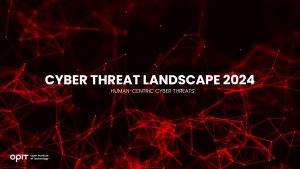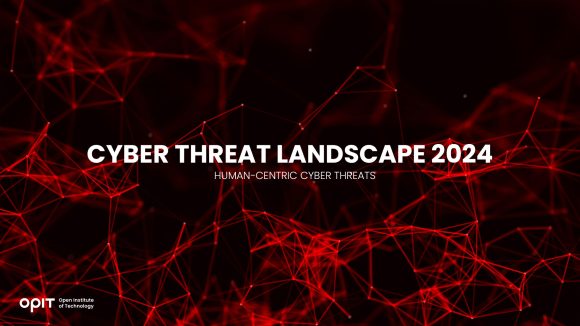

Human-centric cyber threats have long posed a serious issue for organizations. After all, humans are often the weakest link in the cybersecurity chain. Unfortunately, when artificial intelligence came into the mix, it only made these threats even more dangerous.
So, what can be done about these cyber threats now?
That’s precisely what we asked Tom Vazdar, the chair of the Enterprise Cybersecurity Master’s program at the Open Institute of Technology (OPIT), and Venicia Solomons, aka the “Cyber Queen.”
They dedicated a significant portion of their “Cyber Threat Landscape 2024: Navigating New Risks” master class to AI-powered human-centric cyber threats. So, let’s see what these two experts have to say on the topic.
Human-Centric Cyber Threats 101
Before exploring how AI impacted human-centric cyber threats, let’s go back to the basics. What are human-centric cyber threats?
As you might conclude from the name, human-centric cyber threats are cybersecurity risks that exploit human behavior or vulnerabilities (e.g., fear). Even if you haven’t heard of the term “human-centric cyber threats,” you’ve probably heard of (or even experienced) the threats themselves.
The most common of these threats are phishing attacks, which rely on deceptive emails to trick users into revealing confidential information (or clicking on malicious links). The result? Stolen credentials, ransomware infections, and general IT chaos.
How Has AI Impacted Human-Centric Cyber Threats?
AI has infiltrated virtually every cybersecurity sector. Social engineering is no different.
As mentioned, AI has made human-centric cyber threats substantially more dangerous. How? By making them difficult to spot.
In Venicia’s words, AI has allowed “a more personalized and convincing social engineering attack.”
In terms of email phishing, malicious actors use AI to write “beautifully crafted emails,” as Tom puts it. These emails contain no grammatical errors and can mimic the sender’s writing style, making them appear more legitimate and harder to identify as fraudulent.
These highly targeted AI-powered phishing emails are no longer considered “regular” phishing attacks but spear phishing emails, which are significantly more likely to fool their targets.
Unfortunately, it doesn’t stop there.
As AI technology advances, its capabilities go far beyond crafting a simple email. Venicia warns that AI-powered voice technology can even create convincing voice messages or phone calls that sound exactly like a trusted individual, such as a colleague, supervisor, or even the CEO of the company. Obey the instructions from these phone calls, and you’ll likely put your organization in harm’s way.
How to Counter AI-Powered Human-Centric Cyber Threats
Given how advanced human-centric cyber threats have gotten, one logical question arises – how can organizations counter them? Luckily, there are several ways to do this. Some rely on technology to detect and mitigate threats. However, most of them strive to correct what caused the issue in the first place – human behavior.
Enhancing Email Security Measures
The first step in countering the most common human-centric cyber threats is a given for everyone, from individuals to organizations. You must enhance your email security measures.
Tom provides a brief overview of how you can do this.
No. 1 – you need a reliable filtering solution. For Gmail users, there’s already one such solution in place.
No. 2 – organizations should take full advantage of phishing filters. Before, only spam filters existed, so this is a major upgrade in email security.
And No. 3 – you should consider implementing DMARC (Domain-based Message Authentication, Reporting, and Conformance) to prevent email spoofing and phishing attacks.
Keeping Up With System Updates
Another “technical” move you can make to counter AI-powered human-centric cyber threats is to ensure all your systems are regularly updated. Fail to keep up with software updates and patches, and you’re looking at a strong possibility of facing zero-day attacks. Zero-day attacks are particularly dangerous because they exploit vulnerabilities that are unknown to the software vendor, making them difficult to defend against.
Top of Form
Nurturing a Culture of Skepticism
The key component of the human-centric cyber threats is, in fact, humans. That’s why they should also be the key component in countering these threats.
At an organizational level, numerous steps are needed to minimize the risks of employees falling for these threats. But it all starts with what Tom refers to as a “culture of skepticism.”
Employees should constantly be suspicious of any unsolicited emails, messages, or requests for sensitive information.
They should always ask themselves – who is sending this, and why are they doing so?
This is especially important if the correspondence comes from a seemingly trusted source. As Tom puts it, “Don’t click immediately on a link that somebody sent you because you are familiar with the name.” He labels this as the “Rule No. 1” of cybersecurity awareness.
Growing the Cybersecurity Culture
The ultra-specific culture of skepticism will help create a more security-conscious workforce. But it’s far from enough to make a fundamental change in how employees perceive (and respond to) threats. For that, you need a strong cybersecurity culture.
Tom links this culture to the corporate culture. The organization’s mission, vision, statement of purpose, and values that shape the corporate culture should also be applicable to cybersecurity. Of course, this isn’t something companies can do overnight. They must grow and nurture this culture if they are to see any meaningful results.
According to Tom, it will probably take at least 18 months before these results start to show.
During this time, organizations must work on strengthening the relationships between every department, focusing on the human resources and security sectors. These two sectors should be the ones to primarily grow the cybersecurity culture within the company, as they’re well versed in the two pillars of this culture – human behavior and cybersecurity.
However, this strong interdepartmental relationship is important for another reason.
As Tom puts it, “[As humans], we cannot do anything by ourselves. But as a collective, with the help within the organization, we can.”
Staying Educated
The world of AI and cybersecurity have one thing in common – they never sleep. The only way to keep up with these ever-evolving worlds is to stay educated.
The best practice would be to gain a solid base by completing a comprehensive program, such as OPIT’s Enterprise Cybersecurity Master’s program. Then, it’s all about continuously learning about new developments, trends, and threats in AI and cybersecurity.
Conducting Regular Training
For most people, it’s not enough to just explain how human-centric cyber threats work. They must see them in action. Especially since many people believe that phishing attacks won’t happen to them or, if they do, they simply won’t fall for them. Unfortunately, neither of these are true.
Approximately 3.4 billion phishing emails are sent each day, and millions of them successfully bypass all email authentication methods. With such high figures, developing critical thinking among the employees is the No. 1 priority. After all, humans are the first line of defense against cyber threats.
But humans must be properly trained to counter these cyber threats. This training includes the organization’s security department sending fake phishing emails to employees to test their vigilance. Venicia calls employees who fall for these emails “clickers” and adds that no one wants to be a clicker. So, they do everything in their power to avoid falling for similar attacks in the future.
However, the key to successful employee training in this area also involves avoiding sending similar fake emails. If the company keeps trying to trick the employees in the same way, they’ll likely become desensitized and less likely to take real threats seriously.
So, Tom proposes including gamification in the training. This way, the training can be more engaging and interactive, encouraging employees to actively participate and learn. Interestingly, AI can be a powerful ally here, helping create realistic scenarios and personalized learning experiences based on employee responses.
Following in the Competitors’ Footsteps
When it comes to cybersecurity, it’s crucial to be proactive rather than reactive. Even if an organization hasn’t had issues with cyberattacks, it doesn’t mean it will stay this way. So, the best course of action is to monitor what competitors are doing in this field.
However, organizations shouldn’t stop with their competitors. They should also study other real-world social engineering incidents that might give them valuable insights into the tactics used by the malicious actors.
Tom advises visiting the many open-source databases reporting on these incidents and using the data to build an internal educational program. This gives organizations a chance to learn from other people’s mistakes and potentially prevent those mistakes from happening within their ecosystem.
Stay Vigilant
It’s perfectly natural for humans to feel curiosity when it comes to new information, anxiety regarding urgent-looking emails, and trust when seeing a familiar name pop up on the screen. But in the world of cybersecurity, these basic human emotions can cause a lot of trouble. That is, at least, when humans act on them.
So, organizations must work on correcting human behaviors, not suppressing basic human emotions. By doing so, they can help employees develop a more critical mindset when interacting with digital communications. The result? A cyber-aware workforce that’s well-equipped to recognize and respond to phishing attacks and other cyber threats appropriately.
Related posts

Life is unpredictable. While many of us have specific hopes and expectations of how our futures will turn out, things don’t always go as expected. There are many variables and unexpected incidents that can interfere and force you to alter your plans, and this is particularly true when it comes to education.
For instance, you might have had plans to study a specific subject, but had to deviate from those plans due to unforeseen circumstances. Or you may have had to enter the workforce in an occupation different from the one you sought in an effort to earn an income, a move that may not provide you with the time or opportunity to achieve your desired educational aims.
In short, every individual’s career pathway is different, and very few go exactly as we expect from the outset. Fortunately, even if you experience a few false starts or sudden twists in your pathway, there are always options available to help you get back on track.
The Unpredictable Nature of Education
In theory, the educational process seems simple. You select a course of study that interests you from the vast array of subjects and prospective professions, select the appropriate classes, acquire the knowledge and skills you need to succeed, and then embark on your profession.
In reality, however, as many people know from firsthand experience, the road to education is often far from straightforward. Here are just some of the many challenges that can take your educational path in a completely different direction:
- Life’s Curveballs: As touched on in the introduction, life is impossible to predict. Financial hardships, health issues, and family emergencies are just some of the unfortunate occurrences that might derail even the most perfectly planned educational regime.
- Changing Interests: People’s desires and preferences don’t necessarily stay the same throughout their entire lives. As you grow, learn, and have new experiences, your interests may change, and so, too, may your educational objectives.
- Pressure and Burnout: Some academic paths are particularly challenging, demanding intense levels of study and hard work. This can sometimes prove too much to bear, even for the most resilient students.
- Failures and Setbacks: Conventional education largely builds around tests and examinations, requiring students to demonstrate their competencies repeatedly. It’s a system that doesn’t suit everyone, and test failures can lead to setbacks and delays.
- Inequality: People can be born with very different privileges and levels of access to education. Those in certain parts of the world may find it much more challenging to complete their education path for financial, cultural, or even political reasons.
- Late Bloomers: People develop at different paces. Some may struggle educationally early on in their lives, forcing them to make certain concessions or sacrifices related to their studies, only to find their feet later in life once they’ve entered the world of work.
Whether you’re a late bloomer, have had your educational aspirations delayed by personal problems, desire to learn new skills and try something different, or want to begin a fresh chapter in your professional life, the Open Institute of Technology (OPIT) may be able to help.
Introducing OPIT
OPIT is an online teaching platform, making high-level technological educational programs accessible to all, no matter their age or background. Offering education in fields like computer science, artificial intelligence, and digital business, OPIT provides a curated collection of degrees. In addition, they offer classes taught by world-leading tutors imparting the wisdom and skills students need to achieve their goals and become the tech leaders of tomorrow.
Meanwhile, for those who have had somewhat tumultuous or unpredictable educational paths, OPIT offers the perfect course corrector: the OPIT Foundation Year.
The OPIT Foundation Year
OPIT’s Foundation Year is a Pre-Tertiary Certificate in Information Technology, fully aligned with MQF/EQF Level 4 standards and valued at 60 ECTS credits. Lasting just one year, this program essentially serves as a comprehensive yet accessible springboard towards higher-level education, creating a path towards degrees and careers in dynamic, flexible fields, like computer science and digital business.
Like other OPIT programs, the Foundation Year is delivered entirely online via the OPIT Virtual Learning Environment. Combining live lectures, asynchronous content, and interactive assessments, students enjoy diverse and dynamic study experiences, acquiring core skills like academic writing, mathematics, and computer literacy, and building a bedrock of knowledge and confidence before taking their next steps.
Who Is the Foundation Program For?
The Foundation Program is designed to provide a solid base upon which to build the technological education many students need. It’s the perfect choice for those who are eager and ambitious to enter professions in AI, data science, and computing, but don’t feel that they have the necessary core skills and knowledge needed to dive straight into a degree.
Entry requirements are relatively relaxed in order to allow as many students as possible to enjoy the benefits of this program. With that said, applicants should ideally hold an MQF/EQF Level 3 or equivalent qualification, with the intention of pursuing a bachelor’s degree. A minimum of B2 level of English proficiency is also required, as this is the working and studying language of the institution.
What the Foundation Year Provides
Perhaps you’ve recently graduated, are considering a career change, or finally have the opportunity to return to education after initial delays or unexpected disruptions to your original plans. Either way, the Foundation Year can help you enjoy:
- Greater Self-Confidence: Foundation Year graduates gain the fundamental skills they need to enter degree programs with much more self-belief and assuredness.
- Superior Tech Knowledge: Lasting two terms, this course explores mathematics, academic reading and writing, and provides an introduction to computer hardware and software.
- Foundational Mathematics: Mathematics literacy forms a large part of the study focus for the Foundation Year, helping students feel more comfortable with numbers and formulas.
- Flexible Learning: Unlike more rigid, conventional education environments, OPIT gives you the freedom and flexibility to study at a pace that suits you best, all from the comfort of home.
- Global Community: OPIT is an international institution, with staff and students from all around the world eager to share knowledge, exchange ideas, and help one another.
Take Your Next Steps to Success With the OPIT Foundation Year
If you’re curious about a career in technology or have always wanted to work with AI, data, and computers, but struggled to find the time and opportunities you need to acquire relevant skills and knowledge, the Foundation Program was made for people like you.
It’s the ideal entry point into the exciting world of online education, and the perfect first step towards a prestigious degree from an innovative and increasingly successful institution. Download the brochure to learn more about it, or start your online application, today.

Students today have a broader range of fields of study to choose from than ever before, but with the world becoming increasingly technological and computers increasing in influence and importance, pursuing a career in computer science often proves a smart, strategic choice.
There are numerous benefits and career paths associated with studying and working in computer science, and we’ll be listing just a few of them in this guide.
High Average Salaries
With the rising cost of living in many parts of the world, it’s unsurprising that many students are thinking several decades ahead to determine what level of starting salaries they could obtain in different career fields.
Many are also seeking professions that offer the opportunity for growth and the ability to advance up the ranks over time, thus increasing their salary and their quality of life in the process.
If a strong, stable salary with the opportunity for improved income is one of your top career priorities, computer science should be at or near the top of your list of prospective careers.
According to recent data, computer scientists earn an average of over €65,000 per year, with certain jobs, like IT project leader and data scientist, paying ever higher. Starting salaries are strong, too, with graduates earning anywhere from €46,000 to €60,000, depending on their chosen profession and level of qualifications.
There are similarly high average salaries reported around the world in computer science and related fields such as data science and AI/ML engineering. These numbers are projected to increase in the years to come, pointing to computer science as a way for graduates to get off to the best financial start of any career.
Unrivaled Flexibility
A common problem with some subjects and courses is that they only provide graduates with a narrow set of skills and a similarly narrow range of potential professions to which they can apply those skills.
That’s not the case with computer science. Graduates in this field can enjoy instant access to a remarkably diverse array of career opportunities, with even newer opportunities being created all the time as technology evolves and innovations emerge.
A few of the many industries and roles you might choose to enter in the field of computer science include:
- Healthcare: As a software developer, data analyst, or cybersecurity expert
- Finance: As a fintech engineer, blockchain developer, or security analyst
- Media: As a graphics programmer, AI developer, or game developer
- Education: As an analyst, software developer, or machine learning engineer
Guaranteed Opportunities
Some career paths are more limited than others, with relatively low numbers of opportunities, recurring risks of job loss, or difficulty obtaining employment in the first place.
Again, with computer science, this simply isn’t the case. At a time when 75% of companies plan to embrace AI and other technologies by 2027, and businesses of all sizes and industries are now relying on computers more than ever before, computer science graduates can enjoy almost unbeatable job security.
Opportunities will continue to grow for people with good computing knowledge, whether that be in the obvious fields like software and web development, engineering, and AI development, or more niche sectors.
With so many options, you’re effectively guaranteed a long, rewarding career if you put in the necessary time and effort needed to establish a strong foundation of computing skills.
Rapidly Expanding and Evolving Industries
It’s no secret that the world of technology is a dynamic and fast-moving one. In the past 20 years alone, we’ve seen the proliferation of the internet, the rapid advancement of smartphones and wearable devices, the emergence of AI, and so much more.
In the years ahead, engineers and developers will continue to explore the boundaries of modern technology’s powers and potential, driving new innovations and improvements and opening more exciting job opportunities for those already established and experienced in this field.
Getting into computer science now could therefore provide a solid foundation for a career filled with excitement as you uncover and explore new ways of working with computers in fields as diverse as healthcare, finance, education, entertainment, manufacturing, logistics, and beyond.
Start Your Computer Science Career at OPIT
We’ve discussed some of the many benefits associated with careers in computer science, from the high starting salaries to the rapidly growing array of job options available to graduates. By now, you may be eager to follow this particular career path and take advantage of the wealth of opportunities.
If you’re wondering how to start, the Open Institute of Technology (OPIT) may hold the answers you need. As an exclusively online learning platform, specializing in computer science and digital business, and staffed by some of the world’s leading tech experts, OPIT is producing the tech leaders of tomorrow.
Some of the many advantages of learning with OPIT include:
- Accessible and flexible online education that matches your learning style and schedule
- Heavy focus on real-world applications of the skills you acquire
- An international community of like-minded students from around the globe
- A top team of tutors and lecturers from varying fields and industries
- Progressive assessment of skills and understanding – not constant exams
OPIT offers a small, curated selection of courses for those seeking to gain the technological skills and knowledge to succeed in their chosen areas of expertise. That includes a BSc (Hons) in Computer Science – a six-term program, worth 180 ECTS credits.
Numerous IT industry leaders and experts helped develop this fully accredited undergraduate degree, which is online and accessible to all. Like other OPIT courses, it offers a flexible learning program, with progressive assessments, fast-track options, and the opportunity to be part of a growing community of learners and tutors.
If the benefits of doing a career in computer science interest you, download the OPIT BSc in Computer Science brochure or fill out an online application today and take your first step toward a rewarding and fulfilling profession.
Have questions?
Visit our FAQ page or get in touch with us!
Write us at +39 335 576 0263
Get in touch at hello@opit.com
Talk to one of our Study Advisors
We are international
We can speak in:


